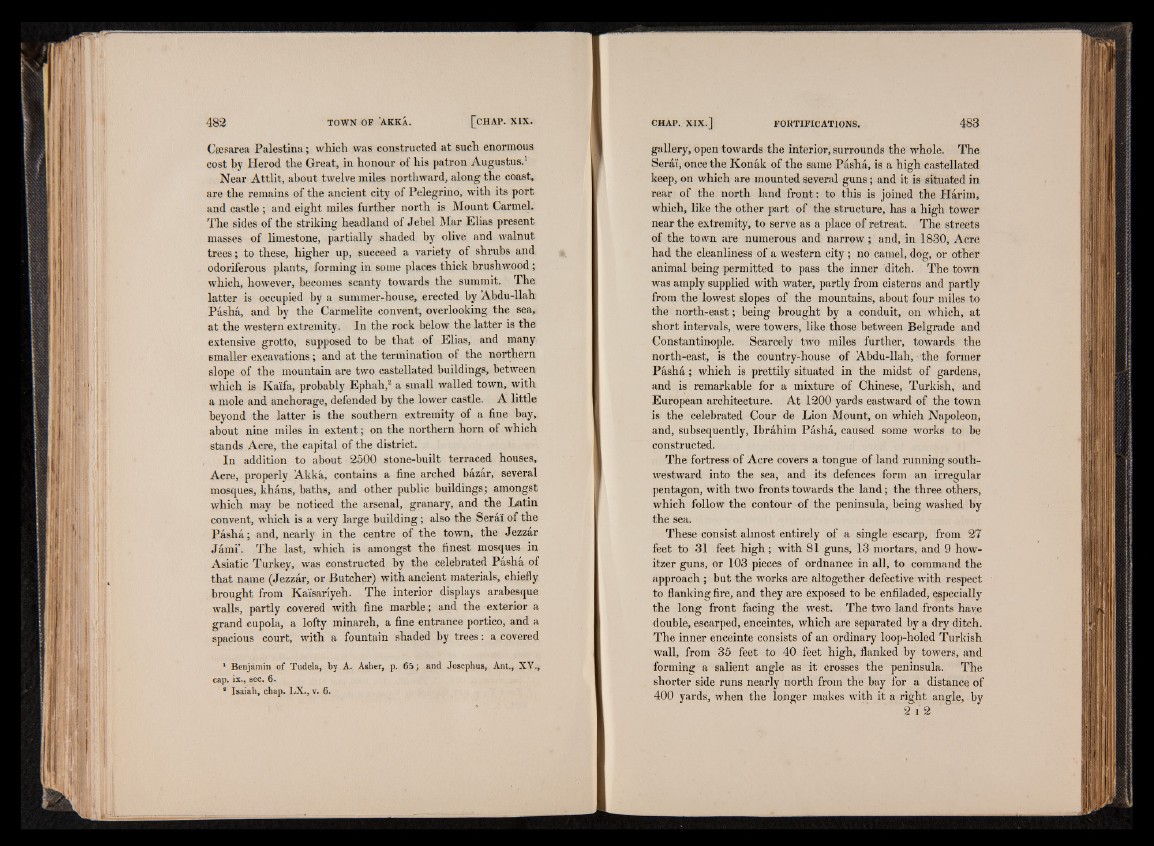
Caesarea Palestina; which was constructed at such enormous
cost by Herod the Great, in honour of his patron Augustus.1
Near Attlit, about twelve miles northward, along the coast,
are the remains of the ancient city of Pelegrino, with its port
and castle ; and eight miles further north is Mount Carmel.
The sides of the striking headland of Jebel Mar Elias present
masses of limestone, partially shaded by olive and walnut
trees; to these, higher up, succeed a variety of shrubs and
odoriferous plants, forming in some places thick brushwood;
which, however, becomes scanty towards the summit. The
latter is occupied by a summer-house, erected by Abdu-llah
Pasha, and by the Carmelite convent, overlooking the sea,
at the western extremity. In the rock below the latter is the
extensive grotto, supposed to be that of Elias, and many
smaller excavations; and at the termination of the northern
slope of the mountain are two castellated buildings, between
which is Ka'ifa, probably Ephah,2 a small walled town, with
a mole and anchorage, defended by the lower castle. A little
beyond the latter is the southern extremity of a fine bay,
about nine miles in extent; on the northern horn of which
stands Acre, the capital of the district.
In addition to about 2500 stone-built terraced houses,
Acre, properly Akka, contains a fine arched bazar, several
mosques, khans, baths, and other public buildings; amongst
which may be noticed the arsenal, granary, and the Latin
convent, which is a very large building; also the Serai of the
Pasha; and, nearly in the centre of the town, the Jezzar
Jami’. The last, which is amongst the finest mosques in
Asiatic Turkey, was constructed by the celebrated Pasha of
that name (Jezzar, or Butcher) with ancient materials, chiefly
brought from Ka'isariyeh. The interior displays arabesque
walls, partly covered with fine marble; and the exterior a
grand cupola, a lofty minareh, a fine entrance portico, and a
spacious court, with a fountain shaded by trees: a covered
1 Benjamin of Tudela, by A. Asher, p. 6 5 ; and Josephus, Ant., XV.,
cap. ix., sec. 6.
* Isaiah, chap. LX., v. 6.
gallery, open towards the interior, surrounds the whole. The
Serai, once the Konak of the same Pasha, is a high castellated
keep, on which are mounted several guns; and it is situated in
rear of the north land front; to this is joined the Harim,
which, like the other part of the structure, has a high tower
near the extremity, to serve as a place of retreat. The streets
of the town are numerous and narrow; and, in 1830, Acre
had the cleanliness of a western city ; no camel, dog, or other
animal being permitted to pass the inner ditch. The town
was amply supplied with water, partly from cisterns and partly
from the lowest slopes of the mountains, about four miles to
the north-east; being brought by a conduit, on which, at
short intervals, were towers, like those between Belgrade and
Constantinople. Scarcely two miles further, towards the
north-east, is the country-house of Abdu-llah, the former
Pasha; which is prettily situated in the midst of gardens,
and is remarkable for a mixture of Chinese, Turkish, and
European architecture. At 1200 yards eastward of the town
is the celebrated Cour de Lion Mount, on which Napoleon,
and, subsequently, Ibrahim Pasha, caused some works to be
constructed.
The fortress of Acre covers a tongue of land running south-
westward into the sea, and its defences form an irregular
pentagon, with two fronts towards the land; the three others,
which follow the contour of the peninsula, being washed by
the sea.
These consist almost entirely of a single escarp, from 27
feet to 31 feet high; with 81 guns, 13 mortars, and 9 howitzer
guns, or 103 pieces of ordnance in all, to command the
approach ; but the works are altogether defective with respect
to flanking fire, and they are exposed to be enfiladed, especially
the long front facing the west. The two land fronts have
double, escarped, enceintes, which are separated by a dry ditch.
The inner enceinte consists of an ordinary loop-holed Turkish
wall, from 35 feet to 40 feet high, flanked by towers, and
forming a salient angle as it crosses the peninsula. The
shorter side runs nearly north from the bay for a distance of
400 yards, when the longer makes with it a right angle, by
2 i 2